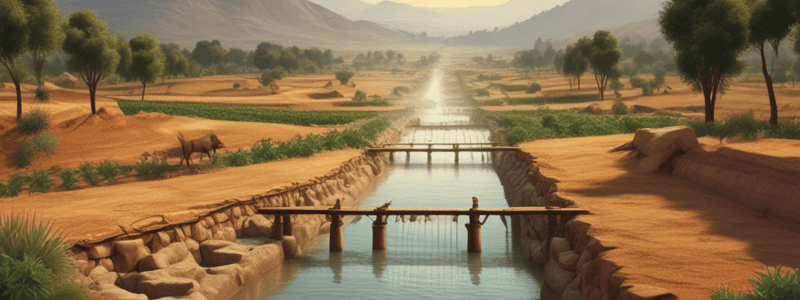Podcast
Questions and Answers
When did the history of irrigation begin?
When did the history of irrigation begin?
- 2000-1500 BCE
- 5000-4000 BCE
- 3000-2500 BCE
- 4000-3500 BCE (correct)
Which ancient civilization developed a complex system of irrigation canals and dams to support agriculture?
Which ancient civilization developed a complex system of irrigation canals and dams to support agriculture?
- Ancient Egyptians
- Ancient Indus Valley Civilization (correct)
- Ancient Sumerians
- Ancient Mesopotamians
What is the main purpose of irrigation in agriculture?
What is the main purpose of irrigation in agriculture?
- To reduce soil moisture and temperature
- To supply crops with water during periods of drought or low rainfall (correct)
- To decrease crop yields and quality
- To increase soil salinity and alkalinity
What type of irrigation system distributes water over the soil surface through canals, ditches, and furrows?
What type of irrigation system distributes water over the soil surface through canals, ditches, and furrows?
What is a benefit of irrigation in agriculture?
What is a benefit of irrigation in agriculture?
What is a challenge of irrigation in agriculture?
What is a challenge of irrigation in agriculture?
Which ancient civilization built sophisticated irrigation systems, including canals and dams, to support agriculture?
Which ancient civilization built sophisticated irrigation systems, including canals and dams, to support agriculture?
What type of irrigation system applies water directly to the roots of plants through drips or micro-sprinklers?
What type of irrigation system applies water directly to the roots of plants through drips or micro-sprinklers?
Flashcards are hidden until you start studying
Study Notes
History of Irrigation
- The history of irrigation dates back to ancient civilizations around 4000-3500 BCE.
- Early irrigation systems were developed in Mesopotamia, Egypt, and the Indus Valley.
- The ancient Sumerians in Mesopotamia built sophisticated irrigation systems, including canals and dams, to support agriculture.
- In ancient Egypt, the Nile River was used for irrigation, and the construction of canals and reservoirs allowed for the expansion of agriculture.
- The ancient Indus Valley Civilization developed a complex system of irrigation canals and dams to support agriculture.
Irrigation in Agriculture
- Irrigation is the artificial application of water to soil to support plant growth.
- Main purposes of irrigation in agriculture:
- To supply crops with water during periods of drought or low rainfall.
- To control soil moisture and temperature.
- To reduce soil salinity and alkalinity.
- To increase crop yields and quality.
- Types of irrigation systems:
- Surface irrigation: water is distributed over the soil surface through canals, ditches, and furrows.
- Sprinkler irrigation: water is sprayed over the soil surface through sprinklers.
- Micro-irrigation: water is applied directly to the roots of plants through drips or micro-sprinklers.
- Flood irrigation: water is applied to the entire soil surface, often used for rice and other crops.
- Benefits of irrigation in agriculture:
- Increased crop yields and quality.
- Reduced soil erosion and sedimentation.
- Improved water use efficiency.
- Enhanced food security and livelihoods.
- Challenges of irrigation in agriculture:
- Water scarcity and competition for water resources.
- Energy consumption and environmental impact.
- Soil salinization and waterlogging.
- High upfront costs and maintenance requirements.
History of Irrigation
- Ancient civilizations developed irrigation systems around 4000-3500 BCE.
- Mesopotamia, Egypt, and the Indus Valley were early centers of irrigation development.
- Ancient Sumerians in Mesopotamia built canals and dams to support agriculture.
- The Nile River was used for irrigation in ancient Egypt, with canals and reservoirs enabling agricultural expansion.
- The Indus Valley Civilization developed a complex system of irrigation canals and dams.
Irrigation in Agriculture
- Irrigation is the artificial application of water to soil to support plant growth.
Purposes of Irrigation
- Supplying crops with water during drought or low rainfall.
- Controlling soil moisture and temperature.
- Reducing soil salinity and alkalinity.
- Increasing crop yields and quality.
Types of Irrigation Systems
- Surface irrigation: distributing water over the soil surface through canals, ditches, and furrows.
- Sprinkler irrigation: spraying water over the soil surface through sprinklers.
- Micro-irrigation: applying water directly to plant roots through drips or micro-sprinklers.
- Flood irrigation: applying water to the entire soil surface, often for rice and other crops.
Benefits of Irrigation
- Increased crop yields and quality.
- Reduced soil erosion and sedimentation.
- Improved water use efficiency.
- Enhanced food security and livelihoods.
Challenges of Irrigation
- Water scarcity and competition for water resources.
- Energy consumption and environmental impact.
- Soil salinization and waterlogging.
- High upfront costs and maintenance requirements.
Studying That Suits You
Use AI to generate personalized quizzes and flashcards to suit your learning preferences.




